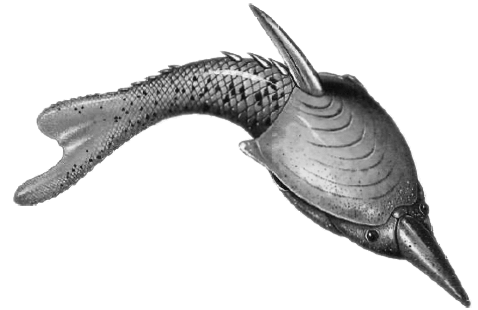|
History of the Universe eBook. 398 pages, 300 illustrations only £5.99
VertebratesAs well as the molluscs or arthropods a third major type of animal appeared during the Cambrian Period around 500 mya. However they were relatively minor until the Ordovician, so we deal with them here. They are called the vertebrates, meaning ďwith backboneĒ. Bone was a key factor in their success. It is not clear which of the invertebrates was their ancestor, perhaps early flatworms. Although not so successful as the other groups in terms of numbers they were far more successful in other ways. Evolution of Vertebrates
Family tree of vertebrates BoneBone is found only in vertebrates. It is made of a protein (collagen) holding a network of mineral crystals made of calcium, phosphate and carbonate. It was originally used by fish as a hard protective outer case, similar to the shells of molluscs and the outer skeleton of arthropods, and it is still used like this around the brain. But of all the major groups of animals, only in vertebrates has the hard covering evolved into a hard inner framework, surrounded by the softer parts of the body. This makes vertebrates vulnerable to damage, but it also gives them the advantage of being able to put on weight and loose weight without having to reshape their outer shell. Immune SystemA unique feature of the vertebrates was the way they could fight infections. They have cells called lymphocytes which invertebrates did not have. Each lymphocyte is able to make a protein called an antibody. Every lymphocyte makes a different antibody from all other lymphocytes.
Scanning electron microscope image of human lymphocyte courtesy of Dr. Triche, US National Cancer Institute. When a lymphocyte meets an invading cell its antibody might stick to a part of the enemy. From all the millions of different lymphocytes at least one has an antibody which will stick. This lymphocyte then begins to reproduce itself in large numbers. Some lymphocytes attack the invader they have stuck to. Others release their antibody, which is carried round in the blood and sticks to invaders in other parts of the body. Different cells called phagocytes can recognize cells with antibody sticking to them, and attack and kill them. This two-pronged attack upon invaders is called the immune system. Once lymphocytes have fought off an attack they never forget. Next time the animal is infected with the same disease it can fight it off much more quickly. Cells of the immune system are made in bone marrow, which is why no animals but vertebrates have this wonderful system. Immune System DiseasesWhen the immune system goes wrong it is called immune deficiency. Aids is acquired immune deficiency, caused by a virus. Sometimes the immune system attacks the animal it belongs to. This causes an autoimmune disease, such as rheumatoid arthritis, juvenile diabetes and perhaps multiple sclerosis. Sometimes the immune system attacks harmless things such as pollen, causing hay fever, or perhaps dust, causing asthma. FishThe animals we lump together as fish actually consist of several very different groups of vertebrates: Ray finned fish Lobe finned fish Jawless FishFish without jaws were the first vertebrates. Just like the molluscs and arthropods, the early fish had a hard outer covering. This armor plating around their front ends was made of bone. Perhaps it was a defense against sea scorpions. The first jawless fish probably appeared about 500 mya during the Cambrian Period, as small fish-like animals called ostracoderms.
Pteraspis - an early jawless fish The Pteraspis shown here is a later example, from the Devonian, but shows the major features. It probably ate by sucking in mud through its mouth and filtered out particles of food as the water left through its gills. Jaws appeared later, and so did paired fins which were used for swimming. Some jawless fish had two fins, some four or more. Many of them had flattened bodies, and were probably not very agile. Early fish contained a swim bladder -- a bag of air to help them float. The strong bone casing around the head allowed the brain, eyes and other senses to develop. Some jawless fish still survive today. They are the lampreys and hagfish. GlaciationAt the end of the Ordovician, Gondwana moved over the South Pole. This led to a glaciation and a fall in sea level which dried out the shallow seas inhabited by most marine species. This had a profound effect upon life. Ordovician-Silurian Mass extinctionBecause of the glaciation described above, there was a major mass extinction at the end of the Ordovician when over two-thirds of all marine genera died.
History of the Universe eBook. 398 pages, 300 illustrations only £5.99 |
eBook only £5.99 398 pages, 300 images  "I find the science fabulous...an extremely useful teaching tool." Professor David Christian. Follow @WykenSeagrave |

The complete history of the Universe -- from the Big Bang to 200 my into the future


